We have long been intrigued by ethnic minorities – so much so that we created a business several years ago — “Ethnicities” — based on the import of ethnic craft, fashion and artisanal furniture from Argentina’s Mapuche Indians.
.
The artistic talent and craftsmanship we found was superb and it was great fun and a memorable life experience to be able to try to open up a U.S. market for these ethnic artisans: See http://articles.chicagotribune.com/2004-05-23/news/0405230405_1_international-home-furnishings-market-geometric-artists-and-designers
.
A few years later, we launched into our socially impactful bamboo housing adventure, (CO2 Bambu) which was centered in Northern Nicaragua, working with ethnic Mayagna and Miskito indigenous communities. Less “fun” (man, that was tough!!), but still kept the ethnic flame going: See a beautiful video on our work with Mayagna indians – https://www.youtube.com/watch?v=zzNGsQ3A3zc
Looking back on past choices of travel we are often drawn to countries where the ethnic dimension is palpable through the arts, the architecture, the food and of course the people.
We travelled to Guatemala, where the ethnic population who live in mountainous regions were more vibrant than in our Nicaragua home base. Their textiles, for instance reflected different regional communities, each wearing a dominant color (red, blue, yellow…) based on the natural dye available in their communities.
We also very much enjoyed our time in Morocco where the beauty of Berber women was only matched by the beauty of their jewelry and textiles.
More recently, our current travel through Southeast Asia has been rich with ethnic influence.
In Viet Nam, we spent time in mountain villages during our Ho Chi Minh Trail week long motorbike ride ~ the tall houses of the Bahnar Central Highlands people were particularly memorable ~ http://greenglobaltrek.blogspot.com/2014/04/bahnar-village-village-of-children.html
In Cambodia, the Khmer boat people with their floating villages were highly impressive for their climate adaptation and resiliency ~ http://greenglobaltrek.blogspot.com/2013/09/staring-down-climate-change-flood.html
In Bali, Indonesia, a rich local culture that distinguishes the island as a Buddhist pocket inside the world’s largest Muslim country led to our discovery of the Balinese ethnic culture manifested through Balinese architecture, religion, dress and culinary culture ~ http://greenglobaltrek.blogspot.com/2014/02/30-year-cycle-ceremony-at-gyanyar_20.html
So now, we are in Laos, at the epicenter in Southeast Asia for ethnic minorities -~ one of the reasons we are drawn here. Economically a poor country, yet rich in its’ ethnicities.
 |
| Beautiful painting done by a local painter of a Hmong girl wearing her ceremonial head dress. |
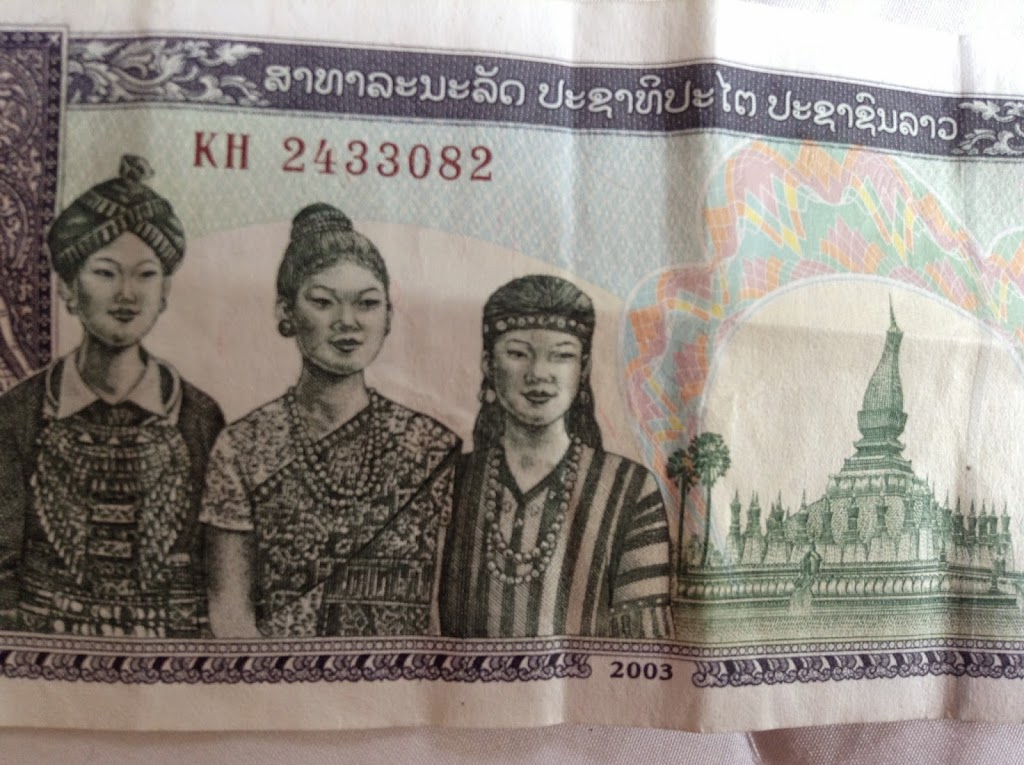 |
| Laotian money ~ the Kip with illustrations of ethnic minorities and temples. (8,000 kip to the dollar) |
The notion of “ethnic minorities” is a misnomer in this part of the world. In fact, ethnic “minorities” are the overwhelming majority in Northern Laos. Mostly rural and living in remote mountain villages, these minorities are an extraordinarily rich cultural asset of Lao.
There are some 100 or so ethnic sub groups, distinguished by their ethnic make up, but also by their languages, clothing, food and cultural practices.
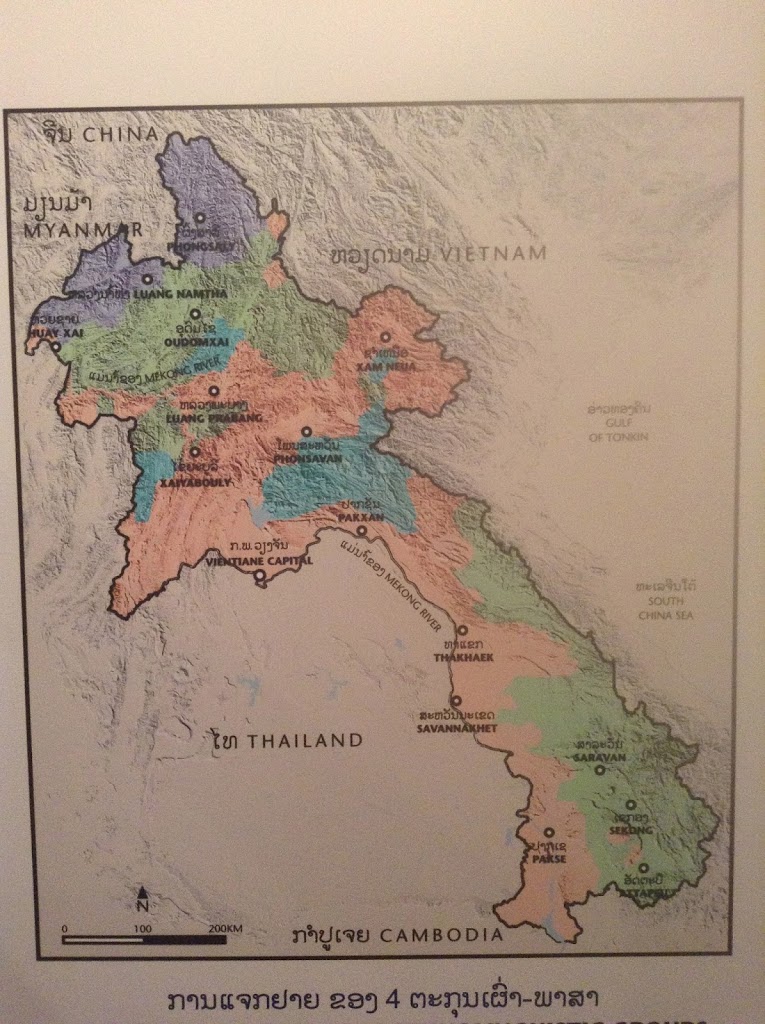 |
| A map of Laos (at the small cultural center in Luang Prabang) which indicates where the Ethnic minorities live. |
Of course, in a town like Luang Prabang, a large portion of the ethnic population works and lives in this “urban” setting, but their families are from mountain villages and they come to “the city” (it is a city, but feels more like a town), for specific trading opportunities, to attend University, or as novices and monks in the town’s many temples.
These 100 or so ethnic groups can be a few larger ethno-cultural families or groupings, which are:
The Hmong: The most famous ethnic group which today has large overseas communities in the U.S., Australia and France. The history is complicated (and brutal), but essentially, the Hmong partnered with the United States during the Viet Nam War, along with the Lao monarchy, with disastrous results. Squeezed between North Viet Nam’s Viet Cong and the United States, Laos was forced to make a choice between the Laos Pathet and the United States and they opted to side with the U.S. Costly decision.
Ultimately the North Vietnamese won the war (and retributions against the Hmong population was swift and harsh), but not before the U.S. opted for a vast secret war that destroyed northern Laos.
While everyone knows of the American war (or Viet Nam war), few Americans are aware that the U.S. waged a highly bloody war in Northern Laos where they dropped more bombs per person in Northern Lao than they did against Nazi Germany. Trying to disturb the North Vietnamese’ ability to go and replenish in Northern Lao, the U.S. carpeted (cluster bombs), its allies’ land, destroying villages, and killing civilians on a massive scale. This was the outcome of the Hmong people’s support of the U.S. war effort.
The Hmong were considered the most ardent soldiers with detailed knowledge of the mountainous terrain. After the war, many Hmong sought to escape retribution from Viet Nam and resettled in the U.S., Australia and France.
This region has the dubious record of having the largest amount of bombs dropped than any other country in the history of the world. To this day, the quantity of UXO (Unexploded Ordinance) is so large, that there continue to be victims in the Lao countryside routinely, 40 years after the war ended.
The Khmu: The majority ethnic group in the Luang Prabang province. Traditionally animists, believing in spirits and the spirit world. Unlike the Hmong who came down from China several centuries ago, the Khmu are the indigenous population of Lao.
The Akha: They live in the far north of the country and are well known for their elaborate headdresses made from silver coins. They have a distinctive traditional cuisine which relies heavily on unique herbs and spices
|
Beautiful silver and silver plated necklaces worn by Hmong people at marriages. The richer the family, the heavier the necklace.
|
 |
|
Today in Luang Prabang, as a UNESCO world heritage site, there are many lovely restored wooden shops with ethnic jewelry, clothing and artifacts.
|
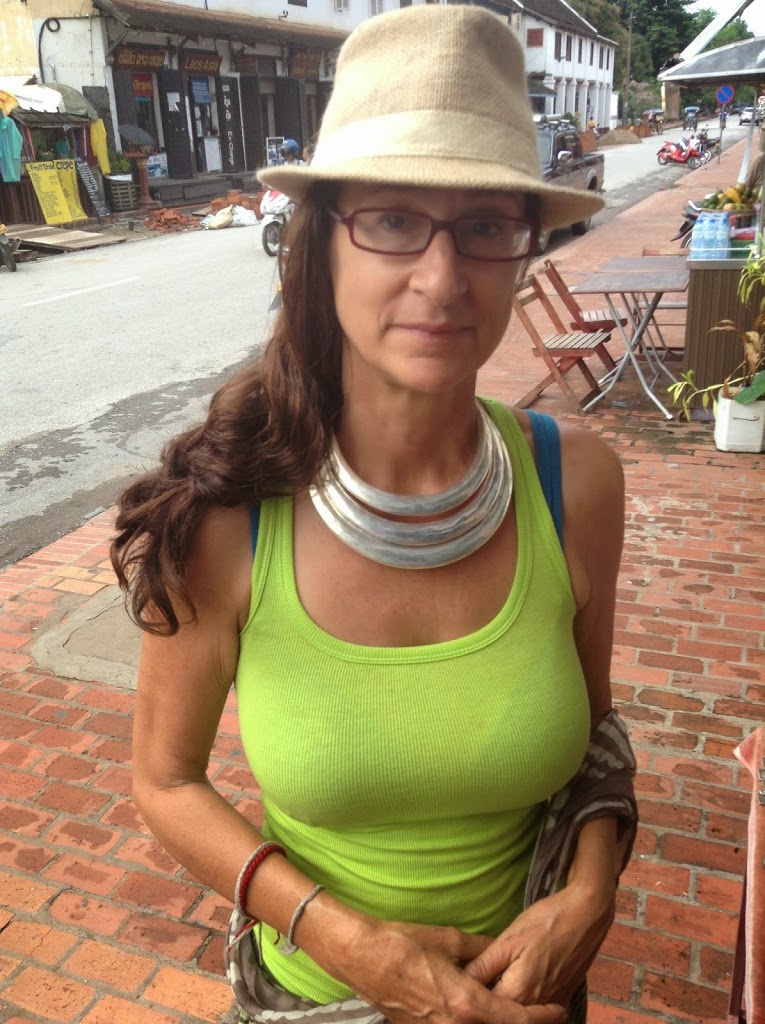 |
| Peta, trying out one of the lighter Hmong silver necklaces. |
We are delighted and surprised to discover a local (twice a week) fashion show of ethnic clothing at one of the restaurants in town.
The models are Hmong university students, who are given the opportunity to showcase their ethnic heritage to the public as well as have a side job of modelling.
With stages in the garden and musical accompaniment, the fashion show is absolutely entrancing and captivating. An amazing opportunity to see a large variety of traditional clothing made from hand dyed fabrics, with textile weaving and intricate hand stitched embroidery. Some of the clothing is worn daily and other pieces are for celebrations and festivals.
|
|
|
University students from the Hmong group, model their traditional clothing in Luang Prabang.
|
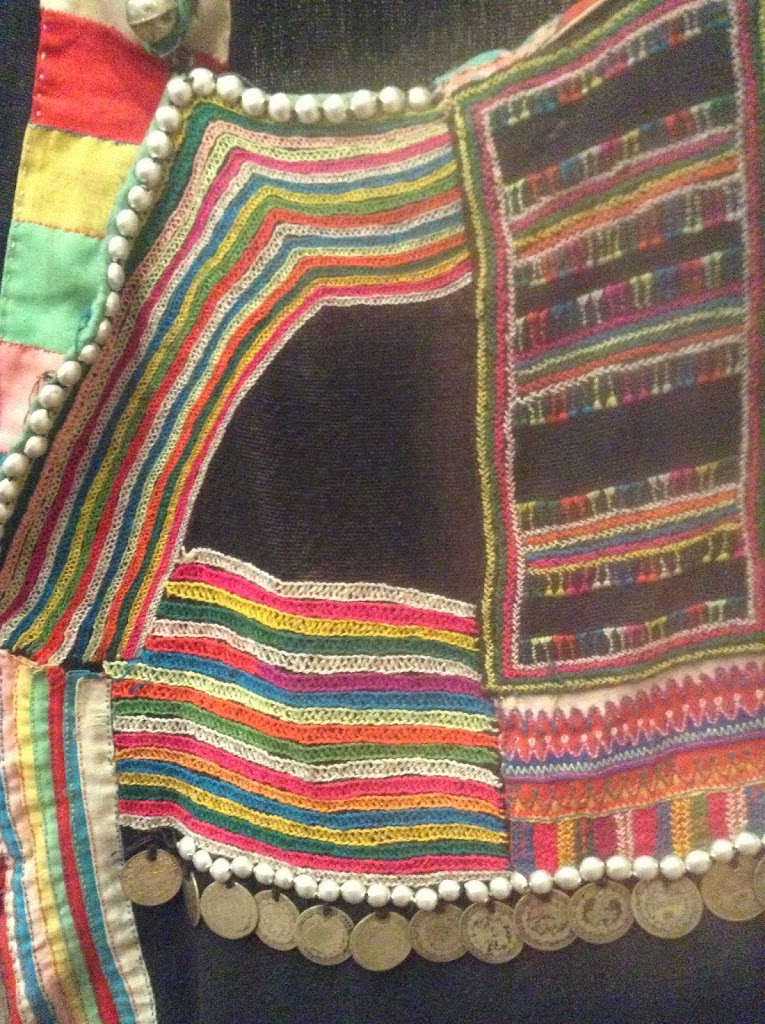 |
| A close up of hand stitching and silver coins in a row underneath. |
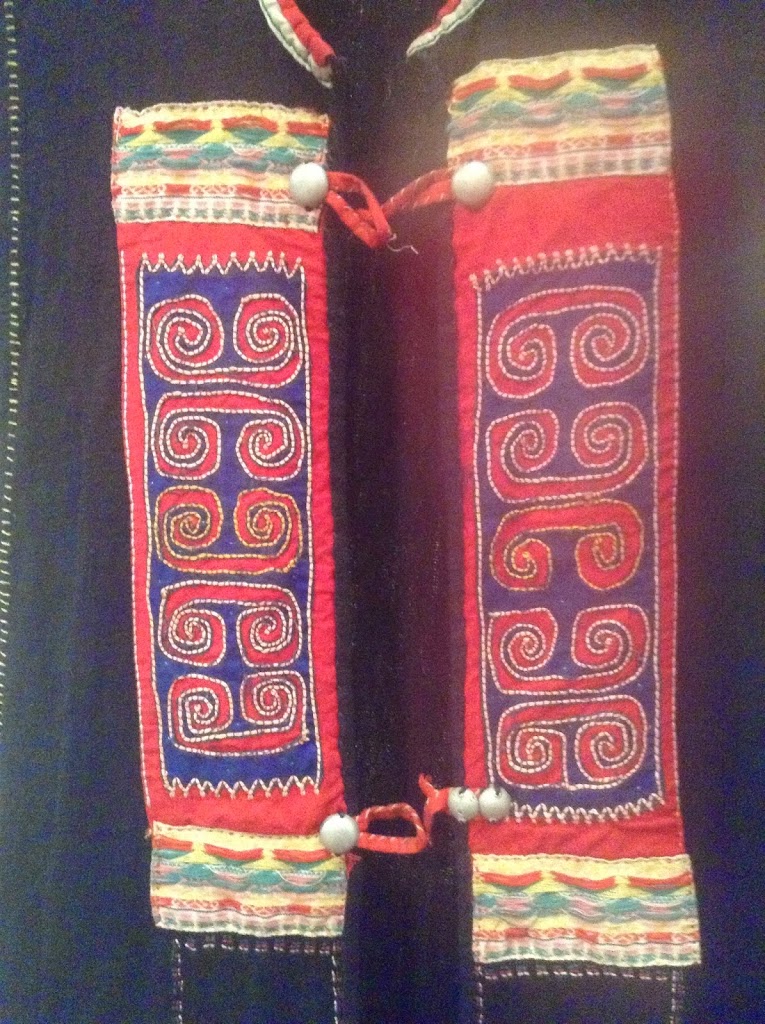 |
| Embroidery design and detail on the front of a Hmong jacket. |
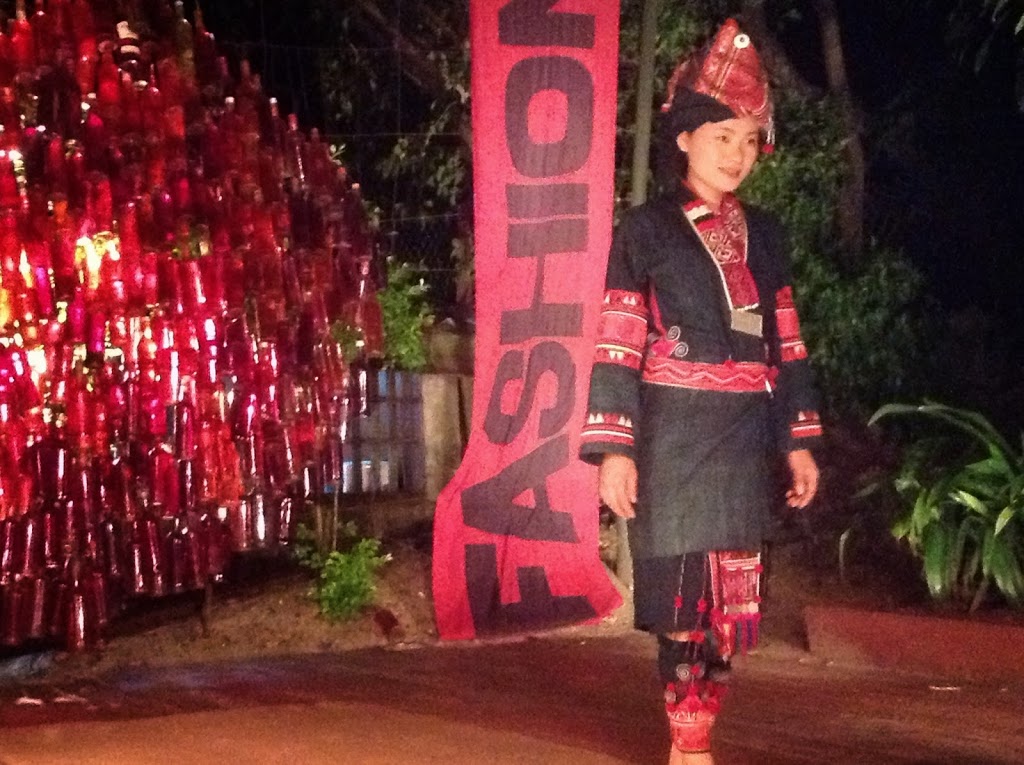 |
|
Head gear, wrapped fabrics, detailed belts and embroidery all create a layered ethnic fashion
|
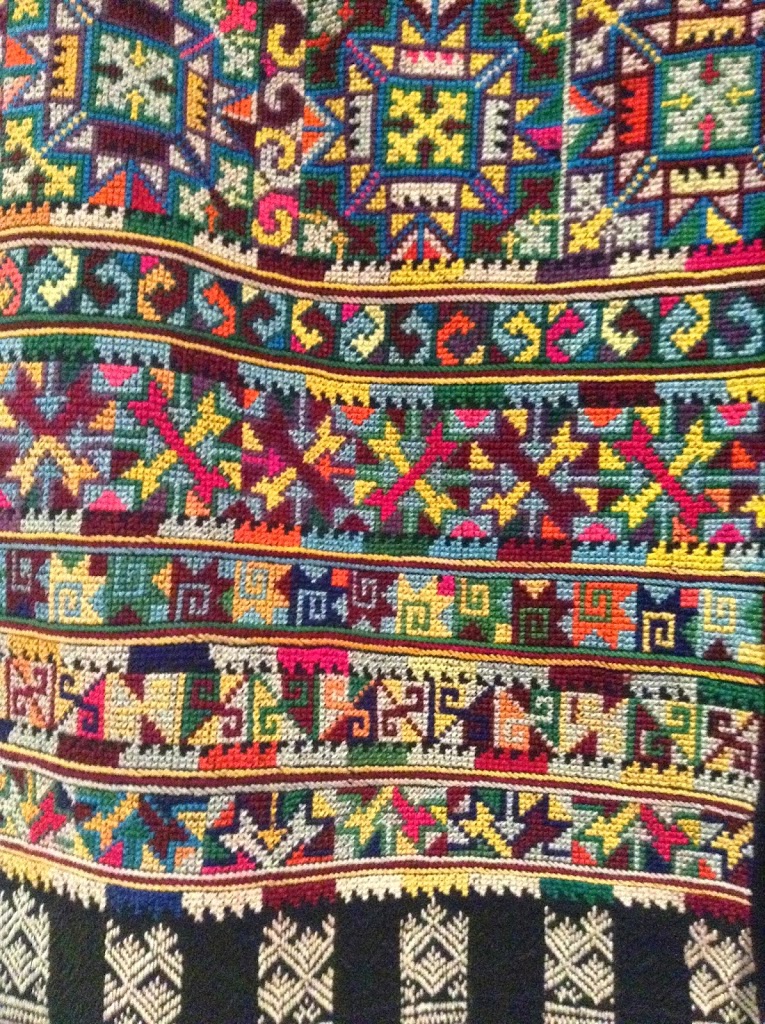 |
|
Beautiful hand work detail on a pair of pants.
|
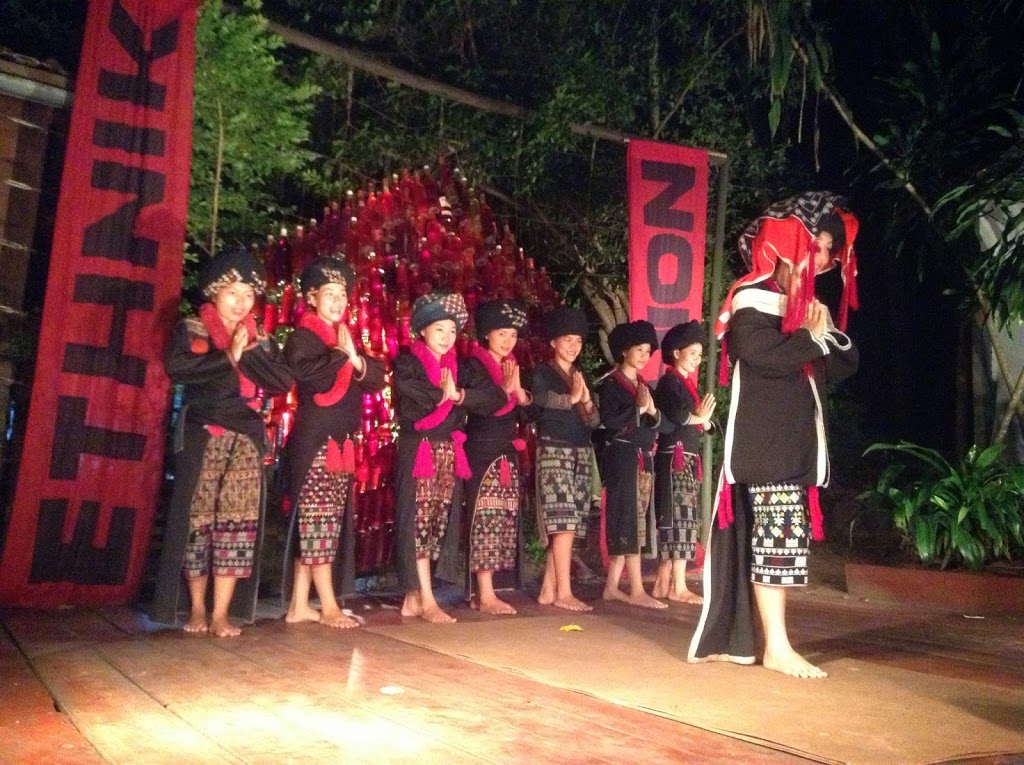 |
|
Love the embroidered pants and wrapped head gear combined with the long black jackets highlighted by ruby tassles and fluffy trim.
|
 |
| Non verbal communication for “who is this strange, white haired falang?” |
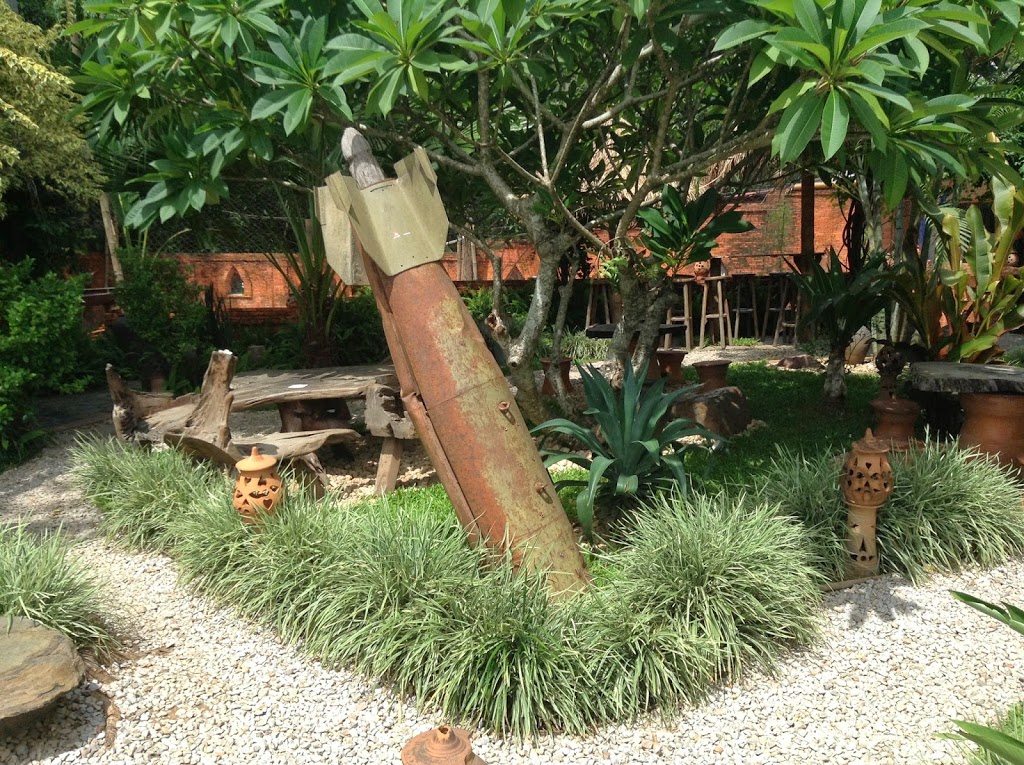
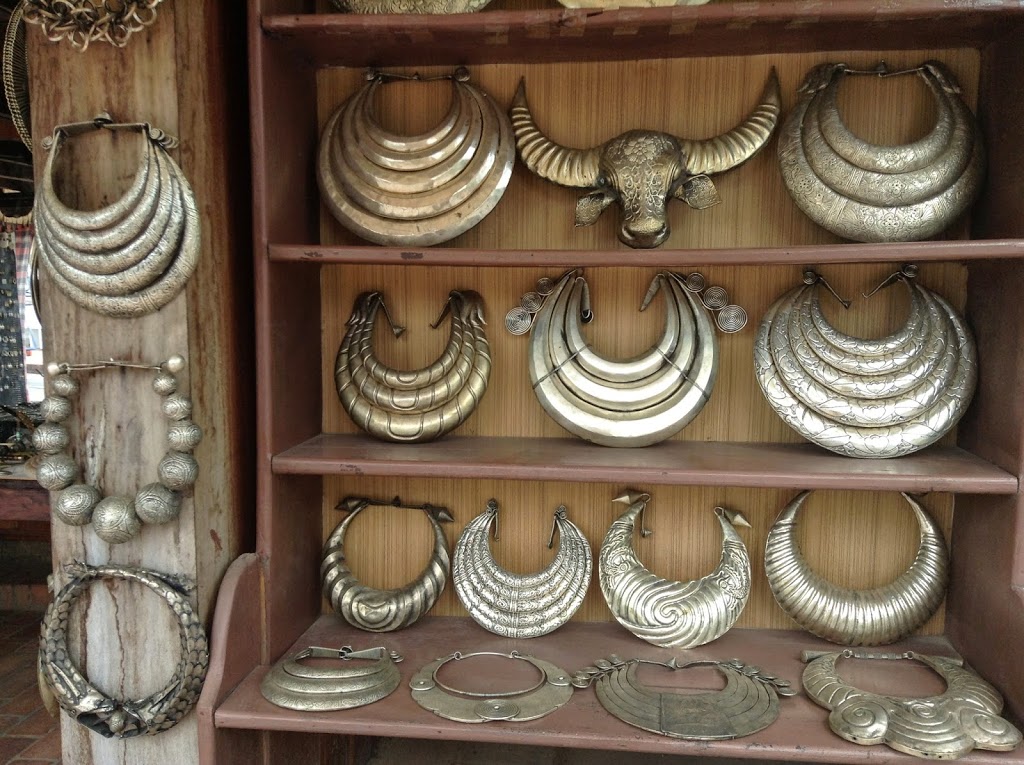
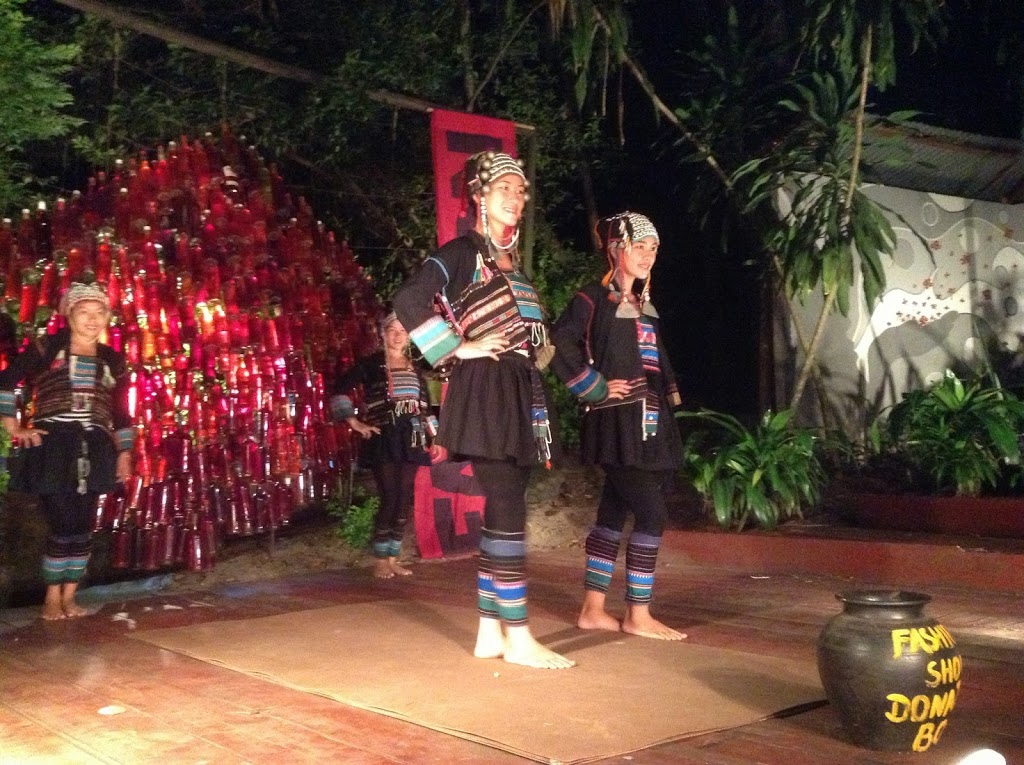
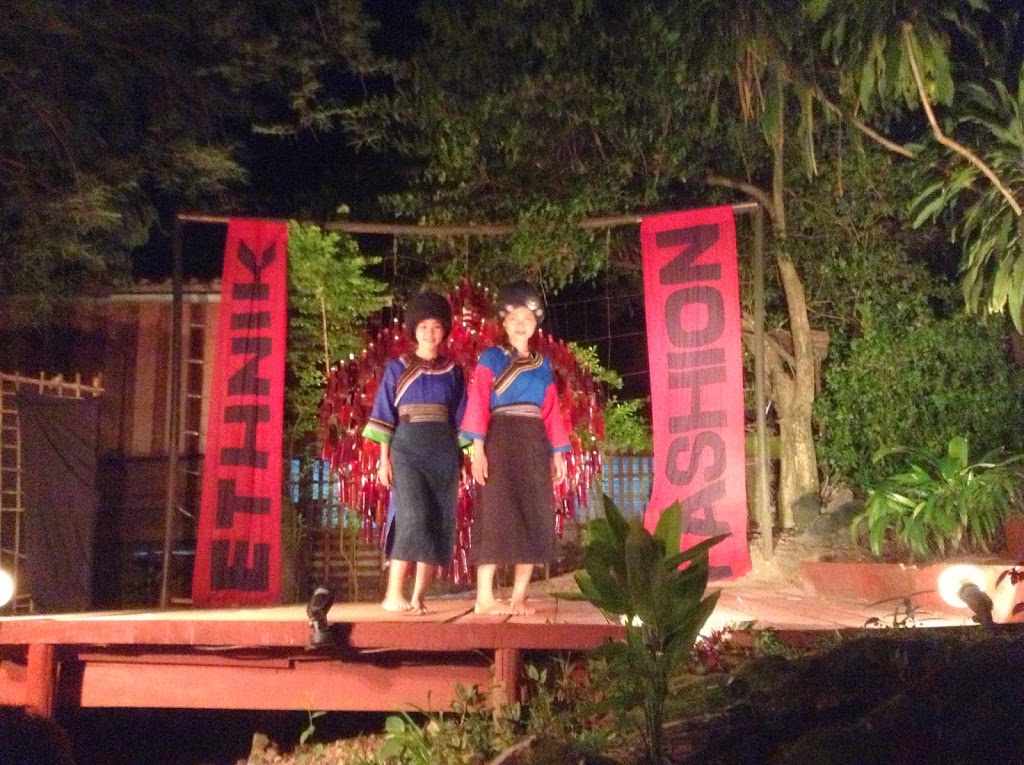
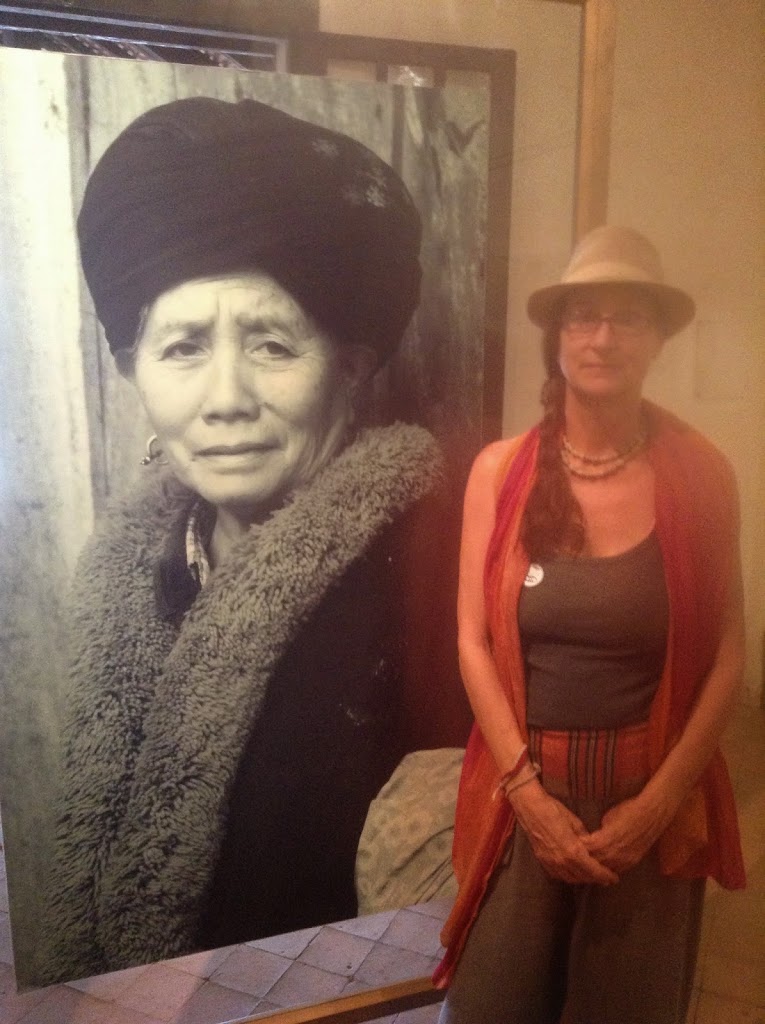
Such an interesting post. I am one of those individuals that was completely unaware of the unknown war brought about by the Americans on the people of Northern Laos but now I have been informed, with my interest piqued, I am going to have to go and find out more. I love the idea of the fashion shows and the clothing and jewellery becoming an integral part of life now – it looks beautiful!
Hi Tam, thank you! We too knew very little about the shocking history of Laos before coming here. One of the amazing things about going to new countries is the huge learning curve that takes place overall. This is a very beautiful country, that is for sure!